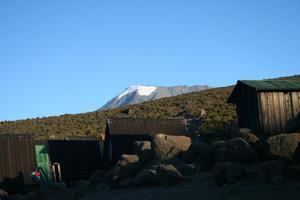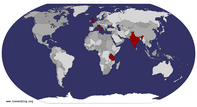Advertisement
Published: September 25th 2006

 mawenzi
mawenzi
the challenge1 in 5 climbers make it to the snow-capped peak nearly 6000 m to the roof of Africa.
The mountain the local and notoriously entrepreneurial Chagga tribe call 'Mountain of God' was formed 20-30 million years ago during the faulting of the Great Rift Valley, whose furrows run right across Tanzania as part of its trail from Lebanon to Mozambique. It has 3 main peaks - Kibo, the summit, actually a large crater formed a mere 100000 years ago, the last time the volcano erupted, Mawenzi and Shira.
Tourists flock from all over the world to take on the challenge of reaching Kibo as no specific climbing gear is needed, just a lot of will power, determination a touch of insanity and warm clothes. Lots of warm clothes.
In 1848 when disillusioned missionary Johannes Rebmann reported snow in Africa, he was ridiculed. When you’re that far up the mountain and you’re wearing all your clothes to get warm. And your own sleeping bag. And someone else’s sleeping bag. And two hats. It doesn’t seem so ridiculous.
It wasn’t too early a start. 9.30 from the Keys hotel. Which would have been fine had it been the right
Keys hotel… Of course Elsie and I only discover this after realizing that the 12 Spaniards we were joining for the climb weren’t actually staying there at the hotel we arrived at.
We treated ourselves to cornflakes at the right Keys hotel and then sussed out the rest of the group we would be spending the next 5 nights with. They looked prepared.
Sure enough, expensive (but worn) boots, and base layers (I now know the term) of different colours and sizes, as well as their own sticks and duffle bags. These guys had taken on a few mountains.
We waited and took snaps, and smiled and ate, and waited and smiled, and took snaps, and waited some more, and was quoted wazungu prices for maps of kili and were brought stupid sized boots to wear and waited some more and eventually the ‘Love Story’ bus turned up full of smiling Tanzanians. All buses here have names. I saw Hans Blix and Ja Rule the other day so I was pretty pleased to start our hike with a little bit of love.
In Africa there are two things
1) Nothing is ever full
2) Time doesn’t exist

 prehistoric
prehistoric
lichen cover trees line the lower slopes of the mountainWaiting to climb Kili we saw both these in action.
The first was with fitting everyone into the Love Story, as we just made more and more space for people. On daladalas (crazily driven communal mini-busses), pompon-sporting conductors squeeze more and more people onto the overflowing bus, getting old men and pregnant ladies to sit on one another as you are wedged between one person’s backside, another’s crotch and someone else’s breast.
Buses are not the only things that never fill up. Stomachs in Africa are never full and you are ALWAYS expected to eat more. And more. And more.
As for time, it really doesn’t exist.
In Out of Africa, Dinesen writes:
"Natives dislike speed as we dislike noise, it is to them, at the best, hard to bear. They are also on friendly terms with time, and the plan of beguiling it or killing it does not come into their heads. In fact the more time you can give them the happier they are, and if you commission to hold your horse while you make a visit, you can see by his face that he hopes you will be a long, long

 electric skies
electric skies
the view from mandaratime about it. He does not try to pass the time then, but sits down and lives.’
That was written in 1937, and nothing much has changed since then. An African will look at you blankly if you tell him you are in a hurry or that you need something quickly. Or if you dare ask what time a bus might leave.
Needless to say, our departure time of 9.30 turned into 10.30, which was pretty prompt really.
By 11am we reached Marangu gate, one of the entrances to Kilimanjaro national park. Set in lush cool greenery, it is surrounded by pubs and bars including the World Trade Centre, which was looking decidedly empty. Men in brightly-coloured shirts tried to sell us $10 hats through the bus window. One man pushed a chameleon on a stick through to me “Look” he cried. I wasn’t’ sure if he wanted me to buy it, photograph it or eat it.
It was only at Marangu that we discovered we needed our passports. It would of course have been nice to have known that but no one seemed too bothered. It would also have been nice to have had some
climbing boots, but once again no one seemed too bothered. Eventually someone appeared with something other than a size 8 and then tried to charge me extra. Begin asked to pay for someone else’s mistake is pretty common here. Like when the taxi driver gets lost or when the hostel loses your clothes. It’s the tax you pay for being able to afford these things in the first place.
Essentially a white (wo)man is a neverending source of funds. An African’s belly is never full. A white man’s pocket is never empty.
In fact, even on Kili you feel you are looked at for your money. You don’t get the impression that the guides really love their work. This was very different from my experience of climbing in the Uluguru hills. There is a little chat about the area, few questions about yourself and a lack of information about the journey.
‘Chui’ was our most charming guide. At first, I thought he’d earned his nickname for the Star Wars character. He’s tall, and big, quiet, slightly hairy and has an air or respectability about him. However on pushing him, the name means ‘Leopard’ in Swahili. And indeed he

 porter
porter
just some of the load the porters carryis fast and strong: He earned his spots on one particularly climb, when an avanlanche started and within seconds he scooped up a fainting South African and swept her to safety.
‘God’ (Godfrey) was the ever-smiling head guide. Shorter and squatter, with powerful calf muscles everything is a game ‘Chizi kama ndizi’ was his battle cry ‘Crazy like a banana’. The more capricious and younger Amani somehow felt less trustworthy. Though that may have something to do with hitting on Elsie and then phoning his girlfriend. Loudly. “I’m on a mountain”….
It’s the porters you really feel for. These guys make $5 dollars a day as they lug all your gear to the top of the mountain for you. They work hard, look tired and want to make the most of the tourist opportunities that are available. If they are lucky after years of going up and down the mountain carrying other people’s warm clothes, sleeping bags and underwear as well as tins of milk and coffee, on their heads and back, they might get a job as a guide.
We had a long and somewhat chilly wait at Marangu, half a sandwich and some biscuits before
heading off into the low (ish) lying forest. Inches of lichen line the trees and branches, give the whole place an prehistoric feel. It was only a 4 hour walk from Marangu gate to the next stop - Mandara at 2,700m. However, I was pleased that Elsie had insisted we take walking sticks as it was more of a struggle than I had anticipated. The altitude left me slightly breathless and dizzy, though fortunately not as badly as one of the group we were with, who had to be stretched out and fed sugar.
Day 2 of our climb started with a chorus of snoring Spaniards and after a seemingly neverending hobbit-like breakfast we headed off back into the hills. Not only did it feel Lord of the Rings-like, but it looked it too - with forest giving over to gorse-covered mountains ands paths cutting swathes through the landscape. From the back it looked like the fellowship was forging on towards Mordor. And like hobbits we stopped every few hours (or more) for food - usually sugar.
As it got harder to breathe and our legs got heavier we made sure we drank the 3 litres of water
we were each carrying. It helped, and I staved off the headaches that normally afflict people at this stage and that took out another of our party that evening.
Walking above the clouds was magical. We were indeed high and we could see Mawenzi peak getting closer, swaddled in cloud. The story goes that Mawenzi, the older and wiser of the two ‘sister peaks’ got fed of her younger sister’s constant begging and borrowing off her, so hit her over the head - which explains why Kibo has a crater at the top of it.
Sisters, eh? ;o)
By the end of day 2 we made it to Horombo camp, nearly 4000m up, but only just. This is where Elsie started to limp due to an infected foot. She also started to take sick. She was still sick a day later with an obvious fever, couldn’t take any food and could barely stand. So, on the morning of my 34th birthday we decided to have her stretchered off the mountain and back to safety. (Though I do feel the trip down in the stretcher was probably more precarious than anything we had taken on). I paid my seemingly
3 weekly visit to the local hospital and got her checked out for malaria. The tests were inconclusive. She’s better now, but whatever it was has knocked her for 6, and I’ll never know whether I could have scaled that summit. I guess there are some heights that you just aren’t destined to reach.
‘Traveling makes one modest - you see what a tiny place you occupy in the world” wrote Flaubert. I have found this particularly true twice in my life.
Matobo in Zimbabwe is a national park made up of immense sand-coloured boulders precariously perched on top of each other. You can clamber on top of many of them, avoiding the bright multi-coloured lizards and all you can see around you is more rocks, and the odd clump of surprised looking trees.
3,700m up Kilimanjaro, at Horombo camp the morning sun highlights the edges of the clouds below you and the evening rays set the sky on fire. The altitude sickness that kills dozens of climbers each year are testimony to the weakness of man.
When traveling your tiny place in the world is confirmed not just by the giants of
nature but also by other people. Being surrounded by a different culture - whether in the midst of colour and devotional bells and music at a hindu temple or when looked at quizzically if you ask an African what time a bus might leave, it all reminds you just how tiny you are.
Tomorrow I finally get to do something I’ve been wanting to do since I really was tiny. I’m off on safari. Ngorongoro, Seregetti and lake Manyara. I’m hoping to meet a different kind of predator from the ones I normally meet on the street but I’m still expecting to feel tiny.
Xx
Advertisement
Tot: 0.147s; Tpl: 0.013s; cc: 12; qc: 71; dbt: 0.0745s; 1; m:domysql w:travelblog (10.17.0.13); sld: 1;
; mem: 1.2mb
















Anna
non-member comment
Looks cool. but what happened to Elsie!